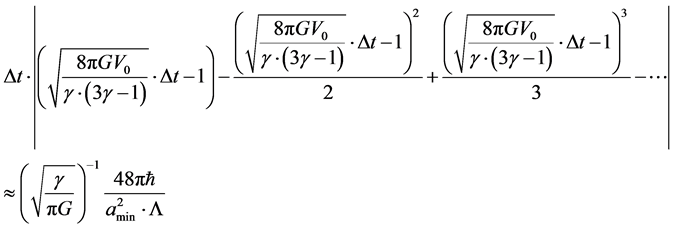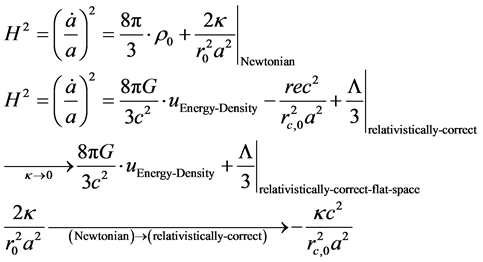Journal of High Energy Physics, Gravitation and Cosmology
Vol.03 No.03(2017), Article ID:78084,10 pages
10.4236/jhepgc.2017.33038
How a Minimum Time Step Leads to a Causal Structure Used to Form Initial Entropy Production and High Frequency Gravitons, with 7 Subsequent Open Questions
Andrew Walcott Beckwith
Physics Department, College of Physics, Chongqing University, Chongqing, China

Copyright © 2017 by author and Scientific Research Publishing Inc.
This work is licensed under the Creative Commons Attribution International License (CC BY 4.0).
http://creativecommons.org/licenses/by/4.0/



Received: March 20, 2017; Accepted: July 28, 2017; Published: July 31, 2017
ABSTRACT
We start where we use an inflaton value due to use of a scale factor . Also we use
. Also we use  as the variation of the time component of the metric tensor
as the variation of the time component of the metric tensor  in Pre-Planckian Space-time up to the Planckian spacetime initial values. In doing so, we come up with a polynomial expression for a minimum time step; we can call
in Pre-Planckian Space-time up to the Planckian spacetime initial values. In doing so, we come up with a polynomial expression for a minimum time step; we can call  which leads to a development of the arrow of time. We show an inter relationship between the formation of the Arrow of time, and Causal structure, assuming the setting of H = 0 in the Friedman equation This in turn leads to entropy production at the start of causal structure in the onset of inflation. This then leads to three and a quarter pages of 7 open questions we think have to be answered, subsequently. It is noted that high frequency gravitational waves as specified are due to the 1/delta t entry in Equation (45) of the document which comes out to about 44 Hertz, and certainly is high frequency gravitational waves for the initial cosmological conditions, so this is definitely about high frequency gravitational wave focused initial conditions.
which leads to a development of the arrow of time. We show an inter relationship between the formation of the Arrow of time, and Causal structure, assuming the setting of H = 0 in the Friedman equation This in turn leads to entropy production at the start of causal structure in the onset of inflation. This then leads to three and a quarter pages of 7 open questions we think have to be answered, subsequently. It is noted that high frequency gravitational waves as specified are due to the 1/delta t entry in Equation (45) of the document which comes out to about 44 Hertz, and certainly is high frequency gravitational waves for the initial cosmological conditions, so this is definitely about high frequency gravitational wave focused initial conditions.
Keywords:
Inflaton Physics, Causal Structure Entropy, HFGW

1. Examination of the Minimum Time Step, in Pre-Planckian Space-Time as a Root of a Polynomial Equation
We initiate our work, citing [1] to the effect that we have a polynomial equation for the formation of a root finding procedure for , namely if
, namely if
 (1)
(1)
From here, we then cited, in [1] , using [2] , a criteria as to formation of entropy, i.e. if  is an invariant cosmological “constant” and if Equation (2) holds, we can use the existence of nonzero initial entropy as the formation point of an arrow of time.
is an invariant cosmological “constant” and if Equation (2) holds, we can use the existence of nonzero initial entropy as the formation point of an arrow of time.
 (2)
(2)
In short, our view is that the formation of a minimum time step, if it satisfies Equation (2) which is a necessary and sufficient condition for the formation of an arrow of time, at the start of cosmological evolution, we have a necessary and sufficient condition for the initiation of an arrow of time. In other words, Equation (2) being non zero with a minimum time step, is necessary and sufficient for the formation of an arrow of time. The remainder of our article is focused upon the issues of a necessary and sufficient condition for causal structure being initiated, along the lines of Dowker, as in [3] .
2. Considerations as to the Start of Causal Structure of Space-Time
In [1] , we make our treatment of the existence of causal structure, as given by writing its emergence as contingent upon having
 (3)
(3)
We have assumed in writing this, that our initial starting point for which we can write a Friedman Equation with H = 0 is a finite, very small ball of space- time and that within this structure that the Friedman Equation follows the following conventions, namely
 (4)
(4)
The relativistically correct Friedman equation assumes, that within the confines of the regime for where H = 0 that we write  equal to zero; i.e. there is no effective curvature within the confines of Pre-Planckian Space-time and that we make the following assumptions, namely that satisfying Equation (3) above is contingent upon [4] where we are assuming that the volume is normalized to =1, i.e. Planck length is set equal to one.
equal to zero; i.e. there is no effective curvature within the confines of Pre-Planckian Space-time and that we make the following assumptions, namely that satisfying Equation (3) above is contingent upon [4] where we are assuming that the volume is normalized to =1, i.e. Planck length is set equal to one.
 (5)
(5)
i.e. the regime of where we have the initiation of causal structure, if allowed would be contingent upon the behavior of [5] [6] [7]
 (6)
(6)
i.e. the right hand side of Equation (6) is the square of the scale factor, which we assume is ~10^-110, due to [5] [6] , and an inflaton given by [8]
 (7)
(7)
These are the items which were enfolded into the derivation of Equation (1) of reference [1] i.e. our following claim is that Causal structure commences if we can say the following,
 (8)
(8)
3. So What Is the Root of Our Approximation for a Time Step?
Here for the satisfying of Equation (8) is contingent upon  as an initial event horizon, of our bubble of space-time being of the order of magnitude of Planck Length, for the satisfaction of forming a regime of space time which may have causal structure as given by Dowker [3] , i.e. at the boundary of a space-time initial bubble [5] [6] which may contravene the Penrose conjecture [9] as to initial singularities.
as an initial event horizon, of our bubble of space-time being of the order of magnitude of Planck Length, for the satisfaction of forming a regime of space time which may have causal structure as given by Dowker [3] , i.e. at the boundary of a space-time initial bubble [5] [6] which may contravene the Penrose conjecture [9] as to initial singularities.
Furthermore, this is not incommensurate with what Penrose wrote himself in [10] , namely reviewing the Weyl Curvature hypothesis, as given in [10] , i.e. singularities as presumed in initial space-time are very different from singularities of black holes, and that modification of the Weyl curvature hypothesis, may be allowing for what Penrose referred to as gravitational clumping initially to boost the initial entropy, above a presumed initial value. i.e. this we believe is commensurate with Equation (2) above, and is crucially important.
We close this inquiry by noting that what we have done is also conditional upon [11] [12] to the effect that we can write the genesis of our time step formula, as given by Equation (1) above as crucially dependent upon, the following
 (9)
(9)
In the third line of Equation (9) the essential substitution is to go from a  in the Newtonian case where we have the universe as bounded if
in the Newtonian case where we have the universe as bounded if 





So, in the Pre Planckian regime of Space-time, our initial assumption is twofold, i.e. we assume that we cannot reference either 


4. Links to Entropy Production
We claim that what we are doing is contingent upon having

The key to this development is accessing the negative energy density in pre Planckian space-time , which if one crosses a causal barrier at H = 0, having this initial energy density, in Pre Causal space-time as negative, which once past the Causal barrier becomes positive, whereas the magnitude of the initial energy would be set at

In doing so, we have the mass if a graviton is specified as in [15] . And then the open question to be asked is, do we have in this case a situation where say the gravitons act as information carriers from a prior universe? Our intuition says yes, and we will follow up upon this with necessary and sufficient conditions for cyclic universe interpretations of this model, in a future publication.
In this case, the mass of a graviton, would be of the order of 10^−62 grams, which would specify, then a very small initial energy if we have that we are also using the Ng approximation for infinite quantum statistics of [16]

As well as an initial frequency of the “particles” given by

We also claim, that this procedure, is in its own way tandem with [17] which in turn has another “bubble” in the start of space-time.
We furthermore claim that additional development of this methodology will entail use of reconciling this work with page 428 of Baez, and Muniain, [18] , specifically as an alternative to the well-researched section on Canonical quantization, used in ADM relativity i.e. what we are doing is by default coming up with an alternative to what has been done in [18] and other places, as well as making a semi classical linkage to gravitons and entropy.
5. Seven Open Questions, Which Remain to Be Answered
To close this section, one of the remaining problems which have to be addressed in this methodology is to address what was brought up by Tolman, [19] , i.e. if we have a cyclical universe that from each cyclical “bounce”, from cycle to cycle, entropy will increase especially at the beginning.
Our Causal structure argument has to be tweaked in order to avoid this development, which will be a topic of a future publication i.e. we need to have exact referencing of a nonzero, but not incrementally increasing initial entropy, per start of a cosmological cycle.
The final set up of our problem will also entail the use of, also reconciling the H = 0 structure of the Causal structure boundary, with what is given for the initial expansion of the Universe as given by [20] , i.e.

Here, the term 


Last but not least, is that we have in our pre causal Pre Planckian structure,

What values of the Cosmological constant are we assuming in the Pre Planckian to Planckian Universe transition?
Either it is of the sort where 

This has to be worked out, for the obvious reasons, as well as looking at, if we have an iterative process for the generation of 

Not only this, we should also consider if we are looking at massive gravitons, an analytical bridge between Pre Planckian representations of Gravitons and the following Planckian, to post Planckian space-time physics as given by a regime of space-time where we go from close to zero, or initially zero Pre Planckian space-time temperatures, to the super-hot initial conditions of inflation, i.e. note that as given by Giovanni, the figure of 1088 as due to gravitons can be seen to come from [5] , page 156 as

There are two questions which this raises: What would be the driving impetus to go from a low temperature pre space time temperature, then to Planck time entropy, then to the entropy of today as given in Equation (18)?
One way to look at it would be to suggest as done by H. Kadlecova [24] in the 12 Marcel Grossman meeting the typical energy stress tensor, using, instead, Gyratons, with an electro-magnetic energy density addition to effective Electromagnetic cosmological value as given by

i.e. that there be, due to effective E and M fields, a boost from an initially low vacuum energy to a higher ones, as given by Kadlecova [24] [25]

How would Equation (25) is used in Equation (11) to Equation (15) affect our Pre Planckian to Planckian physics results? This needs to be considered.
Last but not least, if we are considering massive gravitons, we should look at the following perturbative terms added to a metric tensor by massive gravitons. I.e. understand the 






Here, we have that these are solutions to the following equation, as given by [27]

So the question remains how to be bridge Equation (23) and Equation (24) to the massive graviton conditions we are considering for Pre Planckian space- time? Clearly, Equation (23) and Equation (24) are for Planckian to Post Planckian space-time physics.
Here, we are assuming for Equation (23) and Equation (24)

And use the value of the radius of the universe, as given by 

How do they get bridged to the Pre Planckian regime?
One possible benefit, if we get this matter of information theory and entropy settled i.e. does the following make sense?
In an earlier document the author submitted to FQXI, in 2012, the author tried to make the following linkage between presumed super partners (SUSY), in the electroweak regime of space-time, and the mass of non-super partner particles i.e. in 2012, the supposition was that

In an earlier document, the idea was to make a bridge between presumed total mass of Gravitinos, 
Gravitons, today, which we called,
had 

Equation (26) was a presumed “conservation law”.
The problem, in all this, is that there is still not definitive evidence of super partners in CERN! Nor may there ever be found either! Can we, then if we abandon the idea of super partners, come up with a bridge between Pre Planckian to Planckian physics, using gravitons, along the lines of Equation (26)? This requires a review, of the issues, brought up in [28] , and to see if they are necessary.
We should note in passing that [29] [30] [31] are important considerations, with [29] giving the details of gravitational wave detection, as noted by LIGO in 2016. [30] Confirms the essence of scalar tensor theories as a competitor to General Relativity which should be falsified, if possible, and [31] goes into more of massive body generation of gravitational waves which certainly is appropriate here in the early universe.
With that the questions are laid out for review and consideration.
Acknowledgements
This work is supported in part by National Nature Science Foundation of China Grant No. 11375279.
Cite this paper
Beckwith, A.W. (2017) How a Minimum Time Step Leads to a Causal Structure Used to Form Initial Entropy Production and High Frequency Gravitons, with 7 Subsequent Open Questions. Journal of High Energy Physics, Gravitation and Cosmology, 3, 493-502. https://doi.org/10.4236/jhepgc.2017.33038
References
- 1. Beckwith, A. How a Minimum Time Step Based in Pre Planckian Space-Time If Friedman Equation H Set Equal to Zero Leads to the Arrow of Time. http://vixra.org/abs/1702.0290
- 2. Keifer, C. (2012) Can the Arrow of Time Be Understood from Quantum Cosmology? In: Mersini-Houghton, L. and Vaas, R., Eds., The Arrows of Time, a Debate in Cosmology, Vol. 172, Springer Verlag, Heidelberg, 191-203. https://doi.org/10.1007/978-3-642-23259-6_10
- 3. Dowker, F. Causal Sets and the Deep Structure of Space-Time. https://arxiv.org/abs/gr-qc/0508109
- 4. Beckwith, A. (2016) Gedanken Experiment for Refining the Unruh Metric Tensor Uncertainty Principle via Schwarzschild Geometry and Planckian Space-Time with Initial Nonzero Entropy and Applying the Riemannian-Penrose Inequality and Initial Kinetic Energy for a Lower Bound to Graviton Mass (Massive Gravity). Journal of High Energy Physics, Gravitation and Cosmology, 2, 106-124. https://doi.org/10.4236/jhepgc.2016.21012
- 5. Giovanni, M. (2008) A Primer on the Physics of the Cosmic Microwave Background. World Press Scientific, Hackensack. New Jersey, USA. https://doi.org/10.1142/6730
- 6. Camara, C.S., de Garcia Maia, M.R., Carvalho, J.C. and Lima, J.A.S. (2004) Nonsingular FRW Cosmology and Non Linear Dynamics. Version 1. Arxiv astro-ph/0402311
- 7. Rovelli, C. and Vidotto, F. (2015) Covariant Loop Quantum Gravity. Cambridge University Press, Cambridge, United Kingdom.
- 8. Padmanabhan, T. (2005) Understanding Our Universe; Current Status, and Open Issues. 100 Years of Relativity, Space-Time, Structure: Einstein and Beyond, 175-204. http://arxiv.org/abs/gr-qc/0503107 https://doi.org/10.1142/9789812700988_0007
- 9. Roger, P. (1965) Gravitational Collapse and Space-Time Singularities. Physical Review Letters, 14, 57. https://doi.org/10.1103/PhysRevLett.14.57
- 10. Roger, P. (1981) Time—Asymmetry and Quantum Gravity. In: Isham, C., Penrose, R. and Sciama, D., Eds., Quantum Gravity, a Second Oxford Symposium, Oxford University Press, Oxford, UK, 244-272.
- 11. Roos, M. (2002) Introduction to Cosmology. 2nd Edition, Wiley, New York.
- 12. Ryden, B. and Peterson, B. (2010) Foundations of Astrophysics. Wiley, New York.
- 13. Crowell, L. Notes as to the Recent FQXI Contest. http://fqxi.org/community/forum/topic/2796
- 14. Dou, D. (2001) Causal Sets, a Possible Interpretation for the Black Hole Entropy, and Related Topics. https://arxiv.org/pdf/gr-qc/0106024.pdf
- 15. Goldhaber, A. and Nieto, M. (1954) Mass of the Graviton. PRD Vol. 9, Number 4.
- 16. Ng, J.Y. (2008) Space-Time Foam: From Entropy and Holography to Infinite Statistics and Nonlocality. Entropy, 10, 441-461. https://doi.org/10.3390/e10040441
- 17. Freese, K., Brown, M. and Kinny, W. (2012) The Phantom Bounce: A New Proposal for an Oscillating Cosmology. In: Mersini-Houghton, L. and Vaas, R., Eds., The Arrows of Time: A Debate in Cosmology, Springer Verlag, Fundamental Theories in Physics, Heidelberg, Vol. 172, 149-156.
- 18. Baez, J. and Munian, J. (1994) Gauge Fields, Knots, and Gravity. Part of the Series on Knots and Everything, Vol. 4, World Scientific, Singapore.
- 19. Tolman, R. (1987) Relativity, Thermodynamics, and Cosmology. Dover Publishing Company, Mineola.
- 20. Sarkar, U. (2008) Particle and Astro Particle Physics. Series in High Energy Physics and Gravitation, Taylor & Francis, New York.
- 21. Kolb, E. and Turner, M. (1991) The Early Universe. Westview Frontiers in Physics Series, Vol. 69.
- 22. Beckwith, A. (2011) How to Use the Cosmological Schwinger Principle for Energy, Entropy, and “Atoms of Space-Time” to Create a Thermodynamic Space-Time and Multiverse. Journal of Physics: Conference Series, 306, Article ID: 012064. http://iopscience.iop.org/1742-6596/306/1/012064 http://iopscience.iop.org/1742-6596/306/1;jsessionid=A05372A78C18D970BF35F40A9A863B51.c2
- 23. Penrose, R. (2011) Cycles of Time. Alfred Knopf, New York.
- 24. Kadlecova H. (2012) Gravitational Field of Gyratons Propagating on Backgrounds Formed by Direct Product Space-Time’s. In: Damour, T. and Jantzen, R., Eds., The 12 Marcel Grossman Meetings of General Relativity Proceedings, World Press Scientific, Singapore, Vol. 3, 1899-1901.
- 25. Kadlecova, H., Zelinikov, A., Krtous P. and Podolsky, J. (2009) Gyratons on Direct-Product Space-Times. Physical Review D, 80, Article ID: 024004. https://doi.org/10.1103/PhysRevD.80.024004
- 26. Beckwith, A. (2011) Identifying a Kaluza Klein Treatment of a Graviton Permitting a Deceleration Parameter Q (Z) as an Alternative to Standard DE. Journal of Cosmology, 13, 1-15. http://journalofcosmology.com/BeckwithGraviton.pdf
- 27. Hinterbichler, K. (2011) Theoretical Aspects of Massive Gravity. Reviews of Modern Physics, 84, 671-710. http://arxiv.org/abs/1105.3735.pdf
- 28. The LHCb Collaboration (2015) Determination of the Quark Coupling Strength |Vub| Using Baryonic Decays. Nature Physics, 11,743-747. https://doi.org/10.1038/nphys3415
- 29. Abbott, B.P., et al. (2016) Observation of Gravitational Waves from a Binary Black Hole Merger. PRL, 116, Article ID: 061102. https://physics.aps.org/featured-article-pdf/10.1103/PhysRevLett.116.061102
- 30. Corda, C. (2009) Interferometric Detection of Gravitational Waves: The Definitive Test for General Relativity. International Journal of Modern Physics D, 18, 2275-2282. https://doi.org/10.1142/S0218271809015904
- 31. Abbot, B.P., et al. (2016) GW151226: Observation of Gravitational Waves from a 22-Solar-Mass Binary Black Hole Coalescence. Physical Review Letters, 116, Article ID: 241103. https://doi.org/10.1103/PhysRevLett.116.241103

